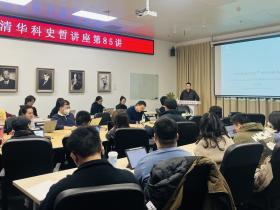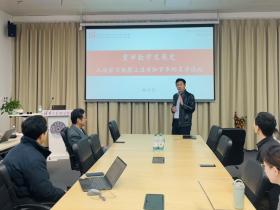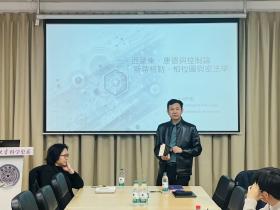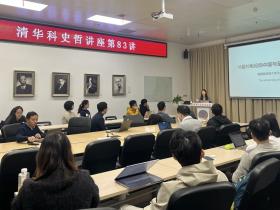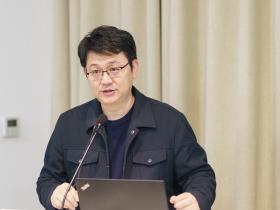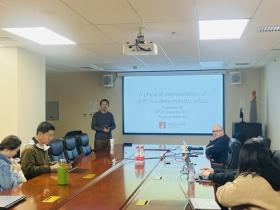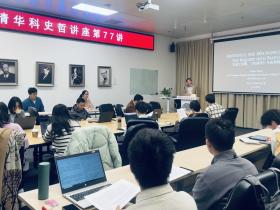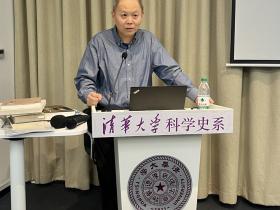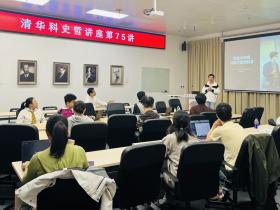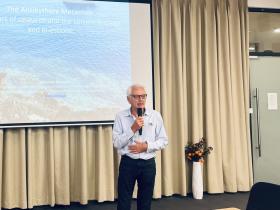On the morning of November 14, 2024, the 80th session of the THU History and Philosophy of Science Lecture Series was held in Room B206 of the Humanities Building. Professor Wang Dongjie from Tsinghua University’s Department of History delivered a lecture titled "Quiet Sitting, Hot-Air Balloon, and Microscope: A Visuality in The Book of Great Unity." Chaired by Associate Professor Shen Yubin, the event drew faculty and students from multiple departments at Tsinghua.
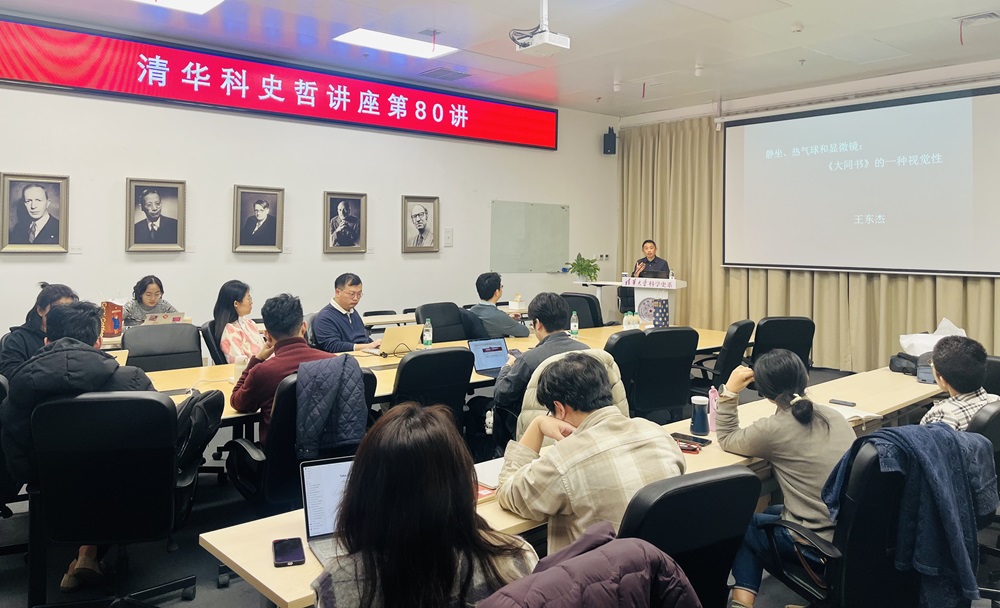
At the outset, Professor Wang Dongjie explained his starting point for studying "visuality," inspired by Peking University Professor Tang Hongfeng’s work Transparency: Chinese Visuality and Modernity (1872–1911) and historian Ernst Kantorowicz. He aimed to use visual concepts to gain insight into thought. "Visuality" refers to "the act, process, and experience of seeing," especially "a series of political and cultural constructions—the conditions that make vision possible," and how it in turn "structures" society and individuals. Visuality reduces abstract ideas to concrete actions; by examining key vocabulary and the perspectives they reveal, it restores the author’s position and stance when making statements—that is, the gaze with which they observe their subject.
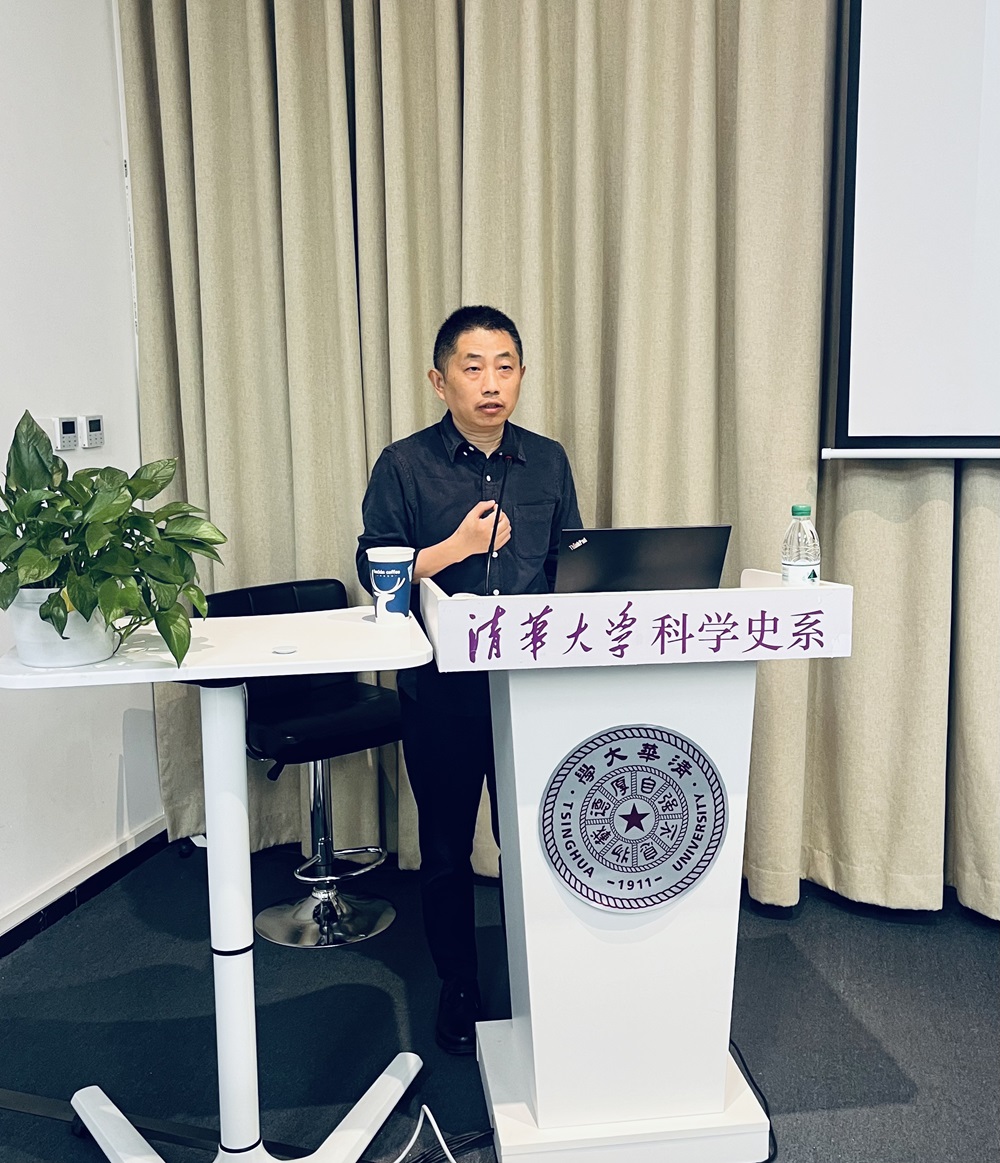
Thus, Professor Wang introduced his specific examination of Kang Youwei’s The Book of Great Unity (Datong Shu), analyzing three sources of Kang’s top-down, outside-in gaze through specific words and phrases. Taking the title of Part A as an example—"Entering the World to Observe Suffering"—both "enter" (入) and "observe" (观) reveal a俯视 (overlooking) gaze from outside to inside.
First: Mystical Experiences Through Quiet Sitting
In the autumn and winter of 1878 (Guangxu 4), 1879 (Guangxu 5), and 1884 (Guangxu 10, during Kang’s "flight from soldiers"), Kang experienced quiet sitting. Behind his self-described motivation to save the world lies a mindset of positioning himself as a Buddha who "enters the world" to rescue all beings. This echoes the final sentence of The Book of Great Unity: "Thus, after the Great Unity, the study of immortality begins, followed by the study of Buddhism. Those of lesser wisdom study immortality; those of higher wisdom study Buddhism. After immortality and Buddhism comes the study of celestial wandering—I have another book on this." It shows that after realizing his salvation ideal, Kang pursued transcendence, forming a complete cycle. As David Armitage noted, "Outer space may be the true final frontier of intellectual history."
Second: Microscopic Exploration in 1884
Kang stated: "Microscopes and thousand-mile lenses are crude instruments... The Way (道) is superior to instruments (器), yet instruments can also transform the Way... I grasped the Great Way through the microscope." He described what he observed: "I saw giant ants like elephants, a chrysanthemum petal like a plantain leaf. In a drop of water, countless creatures had scales and horns, wriggling like dragons. Thus, I realized size has no fixed form." He further proposed that if there were a "shrinking lens," large objects could appear tiny; this perspective also applied to contemplating time’s length and brevity. Here, Kang’s worldview aligns with his quiet-sitting experiences, reflecting the role of thinking patterns and instruments. Hannah Arendt once said three events defined the "modern" character of world history: the discovery of America and global colonization, the Reformation, and "the invention of the telescope and the development of a new science that considers terrestrial nature from a cosmic viewpoint." In visual projection, telescopes and microscopes differ significantly. The telescope’s visuality is egalitarian; the microscope embodies a top-down, outside-in overlooking perspective. The Book of Great Unity presents the world as a unified whole under Kang’s control, while the microscope—increasingly clear at higher magnifications—reveals a nested hierarchical system.
Third: Hot-Air Balloon Experience in Paris, 1904
As recorded in his poem "Song of Ascending a Hot-Air Balloon in Paris":
Soaring, soaring—I now rise to the blue sky in daylight...
Perhaps I have crossed the East Asian Sea, overlooking Yu’s domain with tears.
Or perhaps I have left our filthy world, emerging beyond the heavens...
Suddenly I see the suffering of all beings on Earth.
This conveys Kang’s exhilaration in the俯视 experience.
For Kang Youwei, these diverse experiences shared common associations. Quiet sitting was a traditional mind-body practice; viewing the world through a microscope or Earth from a balloon were sensory realities. These two visually tense experiences reflect the spatiotemporal relativism and omniscient "God’s-eye view" in The Book of Great Unity. Notably, the microscope shaped Kang’s worldview in multiple ways: it offered spatiotemporal scales beyond daily experience and imposed a top-down observational perspective.
Professor Wang noted that The Book of Great Unity’s distinctive modernity manifests on two levels:
- The ideal of Great Unity (Datong) consistently appears alongside a relativist worldview with ethical significance: "Those who look down upon heroes like Napoleon and Wellington see them merely as ant colonies biting each other."
- The ideal reflects a vision for social planning. As Zygmunt Bauman argued: "The societal totality would be a broader, more inclusive territorial hierarchy, with a supra-local state authority perched atop, overlooking the arena." This system absorbs two modes of visual operation: for regulators, it is a transparent space where "the regulated are seen completely and constantly"; the regulated, however, "cannot see the regulators at all, at any time."
In closing, Professor Wang summarized his core thesis: In Kang Youwei’s system, the religious cognition of quiet sitting and the experimental cognition of the microscope are isomorphic—they support, translate, and transform each other. This synthesis reconciles two seemingly opposing modes of thought: one rooted in quiet-sitting experiences, envisioning the cosmos as a unified sympathetic network (an "ether-like" thinking); the other grounded in rational, scientific experience. When discussing the origins of modernity, focusing on the thinking patterns behind phenomena reveals in Kang a modernity echoing indigenous pre-existing experiences.
During Q&A, Professor Shen Yubin noted that Kang Youwei—often viewed conservatively or negatively in recent scholarship—has received scant textual scrutiny. Classical scholars like Kang have been overlooked in the history of Chinese scientific thought. Re-examining late Qing thinkers is essential to determine how modern science influenced their indigenous modernity concepts. Professor Liu Xiao further asked: What position does science occupy in Kang’s description within The Book of Great Unity? Students inquired whether the isomorphism of overlooking experiences was a product of historical context. Professor He Yan (Tsinghua Department of Chemistry) shared personal microscope experiences. Professor Wang addressed each query in detail.
Documented by: Yu Xinya
Reviewed by: Shen Yubin


